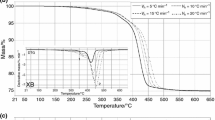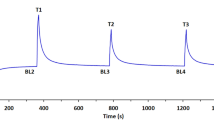Abstract
We have investigated the thermal and structural properties of different commercial dental resins: FiltekTM Z-350, Grandio®, Tetric Ceram®, and TPH Spectrum®. The purpose of the present study was to evaluate quantitatively the photo-polymerization behavior and the effect of filler contents on the kinetic cures of the dental resins by using Differential Scanning Calorimetry (DSC) and Fourier Transform Infrared Spectroscopy (FT-IR) techniques. We have successfully obtained the low and high glass transition T g values of the dental composite resins from DSC curves. It was also observed a good agreement between the both T g values, activation energies from thermal degradation, and the degree of conversion obtained for all samples. The results have shown that Tetric Ceram® dental resin presented the higher T g values, activation energy of 215 ± 6 KJ mol−1, and the higher degree of conversion (63%) when compared to the other resins studied herein.





Similar content being viewed by others
References
Antonucci JM, Stansbury JW. In: Arshady R, editor. Desk reference of functional polymers. Washington, DC: American Chemical Society; 1997.
Moszner N, Salz U. New development of polymeric dental composites. Prog Polym Sci. 2001;26:535–76.
Gatti A, Rastelli ANS, Ribeiro SJL, Messaddeq Y, Bagnato VS. Polymerization of photocurable commercial dental methacrylate-based composites—Photocalorimetry study. J Therm Anal Calorim. 2007;87:631–4.
Wilson KS, Zhanga K, Antonuccia JM. Systematic variation of interfacial phase reactivity in dental composites. Biomaterials. 2005;26:5095–103.
Masouras K, Silikas N, Watt DC. Correlation of filler content and elastic properties of resin-composites. Dent Mater. 2008;24:932–9.
Conti C, et al. Spectroscopic and mechanical properties of dental resin composites cured with different light sources. J Mol Struct. 2005;744–747:641–6.
Anseth KS, Newman SM, Bowman CN. Polymerization kinetics and volume relaxation behavior of photopolymerized multifunctional monomers producing highly crosslinked network. Adv Polym Sci. 1995;122:177–217.
Watts DC. Reaction kinetics and mechanics in photo-polymerised networks. Dent Mater. 2005;21:27–35.
Ferracane JL, Berge HX, Condon JR. In vitro aging of dental composites in water—effect of degree of conversion, filler volume, and filler/matrix coupling. J Biomed Mater Res. 1998;42:465–72.
Li Y, Swartz ML, Phillips RW, Moore BK, Roberts TA. Materials science effect of filler content and size on properties of composites. J Dent Res. 1985;64:1396–401.
Lim BS, Ferracane JL, Condon JR, Adey JD. Effect of filler fraction and filler surface treatment on wear of microfilled composites. Dent Mater. 2002;18:1–11.
Razak AA, Harrison A. The effect of filler content and processing variables on dimensional accuracy of experimental composite inlay material. J Prosthet Dent. 1997;77:353–8.
Soderholm KJ. Influence of silane treatment and filler fraction on thermal expansion of composite resins. J Dent Res. 1984;63:1321–6.
Mohsen NM, Craig RG, Filisko FE. Effects of curing time and filler concentration on curing and postcuring of urethane dimethacrylate composites: a microcalorimetric study. J Biomed Mater Res. 1998;40:224–32.
Lee JK, Choi JY, Lim BS, Lee Y, Sakaguchi RL. Change of properties during storage of a UDMA/TEGDMA dental resin. J Biomed Mater Res B Appl Biomater. 2004;68B:216–21.
Tanimoto Y, Hayakawa T, Nemoto K. Analysis of photopolymerization behavior of UDMA/TEGDMA resin mixture and its composite by differential scanning calorimetry. J Biomed Mater Res B Appl Biomater. 2005;72B:310–5.
Rastelli ANS, Jacomassi DP, Bagnato VS. Effect of power densities and irradiation times on the degree of conversion and temperature increase of a microhybrid dental composite resin. Laser Phys. 2008;18:1074–9.
Achilias DS, Karabela MM, Sideridou ID. Thermal degradation of light-cured dimethacrylate resins: part I. Isoconversional kinetic analysis. Thermochim Acta. 2008;472:74–83.
Bernardi MIB, Rojas SS, Andreeta MRB, Rastelli ANS, Hernandes AC, Bagnato VS. Thermal analysis and structural investigation of different dental composites resins. J Therm Anal Calorim. 2008;94:791–6.
Kanbe H, Ozawa T. Thermal analysis. Tokyo: Kohdansha; 1992. p. 57–64.
Hatakeyama T, Quinn FX. Thermal analysis—fundamentals and applications to polymer science. 2nd ed. New York: Wiley; 1999. p. 82–4.
Acknowledgements
The authors gratefully acknowledge the financial support of the Brazilian financing agencies FAPESP, CNPq, PRONEX/FINEP, and CAPES.
Author information
Authors and Affiliations
Corresponding author
Rights and permissions
About this article
Cite this article
Rojas, S.S., Frigo, G.J.M., Bernardi, M.I.B. et al. Thermal and structural properties of commercial dental resins light-cured with blue emitting diodes (LEDs). J Therm Anal Calorim 99, 263–268 (2010). https://doi.org/10.1007/s10973-009-0521-6
Received:
Accepted:
Published:
Issue Date:
DOI: https://doi.org/10.1007/s10973-009-0521-6




